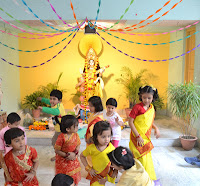 |
| My Saraswati at home. We spent an entire evening looking for the perfect idol for my son. Isn't she beautiful? |
This year on the Saraswati Pujo morning, I get a message
from my childhood hero wishing me a very happy ‘bhalentine day’. Valentines Day indeed for the Bengalis!
Couples hand-in-hand at every corner, young men in white Punjabi/Pajama, women
in bright yellow saris - yes love and festivity is in the air!
A nostalgic day for me. It always takes me back to my
childhood days spent in Durgapur.
 |
| An old scanned picture of our Vivekananda Road house. Baba at work. |
Fuley fuley dholey dholey: Our bungalow in Vivekananda Road and
Andrews Place had a beautiful garden. I remember the layout was more of a
square in Vivekananda Road and triangular in Andrews Place. Come winter and it
would be full of flowers like Dahlia, Chrysanthemum, Marigold and Roses. Baba
and Anil da (our ‘ek paye’, ‘khona’/one
–legged and with a broken voice) gardener would toil hard throughput the year
to ensure that ours looked the best. Well, my parents have always won the
gardening contest organized by DSP, SAIL. We never had to buy flowers for
Saraswati Pujo, our garden had every variety for the deity.
 | |||
| Pink and Bronze colored?? |
Ful churi: No I don’t mean the morning walkers! But the
nocturnal visitors mostly kids, teenagers and miscreants. Saraswati Pujo would
be all about guarding those flowers the night before.The most exciting night
for us. No bed timings for that particular night as we took turns in staying
awake and helping Baba keep a watch
over our precious flowers. Catching a ful
chor (flower thief) was deemed highly heroic. And we tried our best to
catch one as it would inevitably mean catching the eye of the ‘para’
Romeo/Juliet as well. To stay awake the whole night meant lot of liberties. Ma
would keep a flask of tea or coffee for us and we could also rent videos to
watch the whole night.
 |
| Some more colors of the deity |
Code Yellow:
That’s the color of the deity. White is also another option. A week before the
Pujo we would rummage through Ma’s wardrobe looking for the perfect yellow sari
and there would inevitably be a tug of war. Well I have two more sisters, far
prettier and glamorous! So whatever Didi
picked up was considered the best by the two of us and hence the object of
envy! Yellow with a green/red/golden border would be the typical Saraswati Pujo
sari.
Pujor jogaar: Pujo at our house would always commence at 7am
sharp which meant we had to be up very early and compete for the use of the
toilet. Shivering in the wee hours of the morning we would take a bath and then
wait for Didi to help us with our saris.
Our skills lay in making the Marigold garlands for the deity while Didi helped Ma with the alpana and
the noibiddo (fruit offering).
 |
| See how she looks in Orissa. The features are so different! |
The forbidden fruit: The very word noibiddo reminds me of Kul.
Aahhh! The best part about Saraswati Pujo.
Two weeks before the Pujo there would be kul around but we couldn’t have even a single one! Ma’s warnings
rang clear and loud in our heads ‘Kul
has to be offered to the Goddess first. If we don’t then we commit a sin. The
Goddess gets angry and ensures that we live a life without bidda’. Well, this logic of Ma still works for us. I give the same
rationale to my son (who thinks a life without bidda is much better) and I make it a point to have kul only after offering it to the
goddess.
 |
| Pujo at Kidzee, Kolkata |
Boi pujo: Along with the deity, books are also worshipped this
day. This meant a day without books, hence no studies- the best gift that Ma
Saraswati can give us.
Finally the ‘Bhalentine’
day: Such a coincidence that this year Saraswati Pujo was on February 15, a
day after the Angrezi Valentines day.
Dressed in our fineries, this is one day where the para girls and boys have free access to each other. Every household
organizes a Saraswati Pujo and anyone can drop in for the Pujo/Bhog which meant
no one’s entry is questioned by the elders.
Bhuribhog: After the Pujo its then time to gather at someone’s
place for some Khichudi, Labra and chutney.
 |
| Rangoli by the students of KPC Medical College |
By evening our spirits would hit an all-time low as this is one particular day
in the calendar which allows unrestricted freedom, fun and enjoyment to the
youth.This Pujo stands for the youth, by the youth and of the
youth. Hence the only one which places undue emphasis on them.
 |
| Ponjika for February |
No comments:
Post a Comment